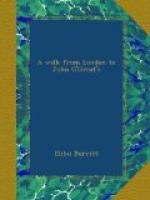I saw, for the first time, a number of Spanish cattle feeding in a pasture. They were large, variously colored animals with the widely-branching horns that distinguish them. A man must have a long range of buildings to stable a score of creatures with such horns, and for that reason they will only be kept as curiosities in these northern latitudes. And they are curiosities of animal life, heightened to a wonderment when placed side by side with the black Galloways, or those British breeds of cattle which have no horns at all. I should not wonder, however, if this large, cream-colored stock from Spain should be introduced here to cross with the Durhams, Devons, and Herefords.
When about half-way from Mansfield to Chesterfield, a remarkable change came over the face of the landscape. The mosaic work of the hill-sides and valleys showed more green squares than before. Three-fourths of the fields were meadow or pasture, or in mangel or turnips. There was but one here and there in wheat or other grain. The road beneath and the sky above began to blacken, and the chimneys of coal-pits to thicken. Sooty-faced men, horses and donkeys passed with loaded carts; and all the premonitory aspects of the “black country” multiplied as I proceeded. I do not recollect ever seeing a landscape change so suddenly in England.
Chesterfield is an intelligent looking town, evidently growing in population and prosperity. It has its own unique speciality; almost as strikingly distinctive as that of Strasburg or Pisa. This is the most ambiguous and mysterious church spire in the world. It would be very difficult to convey any idea of it by any description from an unaided pen; and there is nothing extant that would avail as an illustration. The church is very old and large, and stands upon a commanding eminence. The massive tower supports a tall but suddenly tapering spire of the most puzzling construction to the eye. It must have been designed by a monk of the olden time, with a Chinese turn of ingenuity. There is no order known to architecture




